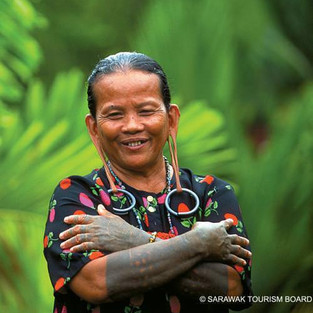Another TWO of the largest indigenous tribes in Sarawak?
- Phoebe Yap

- Mar 7, 2020
- 2 min read
Let us have a short recap on the previous articles!
1. Iban - the largest ethnic group in the Land of the Hornbills 2. Bidayuh - the second largest Dayak ethnic group in Sarawak
3. Orang Ulu - an ethnic group in Sarawak that includes the Penans and Lun Bawang people

The northern region of Sarawak is home to the ‘Orang Ulu’ tribe; a collective name to represent the various ethnic sub-groups. They include the Kelabits, the Lun Bawang, the Berawans and the shy and semi-nomadic Penans. In the region above Kapit and the Pelagus Rapids, the Orang Ulu people literally known as “upriver people”, consists of the Kayans, Kenyahs, Kajangs, Lahanans and the Punans. The Kayan sub-group forms the largest among them.
The Kelabit community can mostly be found in the Kelabit Highlands, in the northernmost part of Sarawak, located about 100km southeast of Gunung Mulu in Bario. The Kelabits and their neighbouring Lun Bawang people produce the fragrant, sought-after Bario rice which is cultivated by hand with no pesticides or herbicides.
The Penans are some of the world's last hunter-gatherers, with a chunk of the community still roaming the rainforests of Sarawak, hunting for wild boars and deer with their blowpipes, made from the Belian Tree. These blowpipes usually come with poison darts made from the bark of Tajem trees which is said to have the ability to kill humans within minutes, if hit by it.
A large number of the people under Orang Ulu ethnic group are Christians but animism based traditional religions are still practiced, especially by the older generations.
4. Melanau - believed to be one of the earliest settlers in Sarawak
The Melanau people make up 5.8% of Sarawak 's population, mostly living in the central coastal region. The Malanaus used to live close to sea and as a result were exposed to many pirate attacks, hence they built sturdy houses some 40ft above ground. Sago is the staple diet of these people, unlike other natives who lived on rice. Originally grown wild, the sago palm was later cultivated by the Melanaus. The process of making sago flour can be seen at the Melanau tallhouse at the cultural centre. Visitors may also savour some of the sago delights that are produced there.

The Melanaus were traditionally farmers, fishermen, and traders but they were most popular for the cultivation of sago palms. Some were even regarded as skilled boat builders. One of the most unique aspects of the Melanau community is their traditional tall houses which are usually built about 40 feet above ground. It mainly served as a sort of protection against pirate attacks at the coastal areas they used to live at and to ensure that the house doesn't get flooded. It was both functional and aesthetically pleasing!
Question: What are the moral values that you learn after reading this article? Do drop me a message, thank you!
References:
Bahauddin, A., & Mustika Syaheeda Awg Musadat, D. (2018). The Traditional Architecture of the Melanau Tall Longhouse, Mukah, Sarawak. SHS Web of Conferences, 45, 01002. https://doi.org/10.1051/shsconf/20184501002
Jehom, W. J. (1999). Ethnicity and Ethnic Identity in Sarawak. Akademika, 55(1), 83–98.
Joshua. (2020). Melanau in Malaysia. https://joshuaproject.net/people_groups/13666/MY
Tu, H. (2020). The indigenous people of Sarawak. Travelfish. https://www.travelfish.org/beginners_detail/malaysia/57










Comments